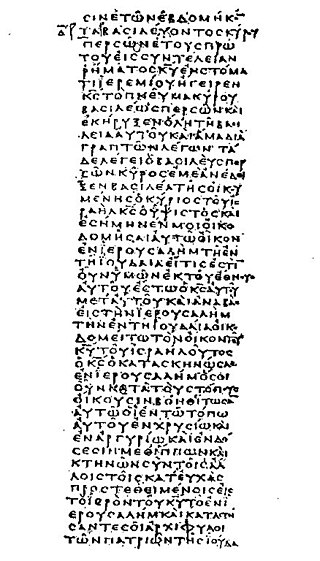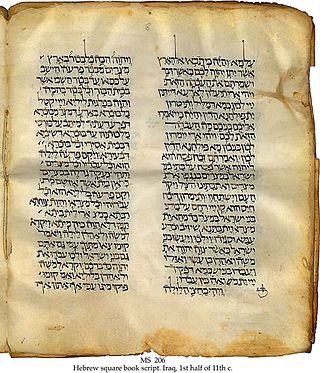
Bible translations into Aramaic covers both Jewish translations into Aramaic (Targum) and Christian translations into Aramaic, also called Syriac (Peshitta).

Bible translations into Aramaic covers both Jewish translations into Aramaic (Targum) and Christian translations into Aramaic, also called Syriac (Peshitta).
Aramaic translations of the Tanakh (Hebrew Bible) played an important role in the liturgy and learning of rabbinic Judaism. Each such translation is called a Targum (plural: Targumim). During Talmudic times the targum was interpolated within the public reading of the Torah in the synagogue, verse by verse (a tradition that continues among Yemenite Jews to this day). Targum is also an important source for Jewish exegesis of the Bible, and had a major influence on medieval interpreters (most notably Rashi). Maimonides (Hilchot Ishut 8:34) writes that the Talmudic definition of a "person who knows how to read and translate the Torah into Aramaic" refers to "the Aramaic translation of Onkelos". [1]
This article needs additional citations for verification .(May 2024) |
In the Syriac (Eastern Aramaic) language the Peshitta (Syriac: "common version") serves as the Bible of churches in the Syriac tradition (Church of the East, Chaldean Catholic, and Syriac Orthodox). The history of Christian Translations of the Bible into Syriac language includes: the Diatessaron, the Old Syriac versions (Curetonian and Sinaitic), the Peshitto, the Philoxenian version, the Harklean Version and the recent United Bible Societies' modern Aramaic New Testament.
About AD 500 a Christian Palestinian Aramaic version was made. It contains 2 Peter, 2-3 John, Jude, and Apocalypse. It is a representative of the Caesarean text-type and is a unique translation different from any other which was made into Syriac. These are among the manuscripts used by John Gwynn in 1893 to complete his edition of the Catholic Epistles. In 1892 Agnes Smith Lewis discovered the manuscript of the Palestinian Syriac lectionary in the library of Saint Catherine's Monastery on Mount Sinai. It is designated by Syrpal.
The first revision of the New Testament from the Syriac into Turoyo language (Western Aramaic in Syriac and Latin script) was made by Malphono Yuhanun Üzel (Bar Shabo), Benjamin Bar Shabo and Yahkup Bilgic in 2009 with notes from Harclean and Philoxenios. This commission "Sihto du Kthovo Qadisho Suryoyo" works specially to preach the Gospel in Aramaic all over the world.
Aramaic is a Northwest Semitic language that originated in the ancient region of Syria and quickly spread to Mesopotamia, the southern Levant, southeastern Anatolia, Eastern Arabia and the Sinai Peninsula, where it has been continually written and spoken in different varieties for over three thousand years.

The Bible is a collection of religious texts or scriptures, some, all, or a variant of which are held to be sacred in Christianity, Judaism, Samaritanism, Islam, the Baha'i Faith, and other Abrahamic religions. The Bible is an anthology originally written in Hebrew, Aramaic, and Koine Greek. The texts include instructions, stories, poetry, prophecies, and other genres. The collection of materials that are accepted as part of the Bible by a particular religious tradition or community is called a biblical canon. Believers in the Bible generally consider it to be a product of divine inspiration, but the way they understand what that means and interpret the text varies.

The Septuagint, sometimes referred to as the Greek Old Testament or The Translation of the Seventy, and often abbreviated as LXX, is the earliest extant Greek translation of the Hebrew Bible from the original Hebrew. The full Greek title derives from the story recorded in the Letter of Aristeas to Philocrates that "the laws of the Jews" were translated into the Greek language at the request of Ptolemy II Philadelphus by seventy-two Hebrew translators—six from each of the Twelve Tribes of Israel.

The Hebrew Bible or Tanakh, also known in Hebrew as Miqra, is the canonical collection of Hebrew scriptures, comprising the Torah, the Nevi'im, and the Ketuvim. Different branches of Judaism and Samaritanism have maintained different versions of the canon, including the 3rd-century BCE Septuagint text used in Second Temple Judaism, the Syriac Peshitta, the Samaritan Pentateuch, the Dead Sea Scrolls, and most recently the 10th-century medieval Masoretic Text compiled by the Masoretes, currently used in Rabbinic Judaism. The terms "Hebrew Bible" or "Hebrew Canon" are frequently confused with the Masoretic Text; however, this is a medieval version and one of several texts considered authoritative by different types of Judaism throughout history. The current edition of the Masoretic Text is mostly in Biblical Hebrew, with a few passages in Biblical Aramaic.

A targum was an originally spoken translation of the Hebrew Bible that a professional translator would give in the common language of the listeners when that was not Biblical Hebrew. This had become necessary near the end of the first century BC, as the common language was Aramaic and Hebrew was used for little more than schooling and worship. The translator frequently expanded his translation with paraphrases, explanations and examples, so it became a kind of sermon.

The Samaritan Pentateuch, also called the Samaritan Torah, is the sacred scripture of the Samaritans. Written in the Samaritan script, it dates back to one of the ancient versions of the Torah that existed during the Second Temple period. It constitutes the entire biblical canon in Samaritanism.

The Bible has been translated into many languages from the biblical languages of Hebrew, Aramaic, and Greek. As of September 2023 all of the Bible has been translated into 736 languages, the New Testament has been translated into an additional 1,658 languages, and smaller portions of the Bible have been translated into 1,264 other languages according to Wycliffe Global Alliance. Thus, at least some portions of the Bible have been translated into 3,658 languages.
The Ketuvim is the third and final section of the Hebrew Bible, after the Torah ("instruction") and the Nevi'im "Prophets". In English translations of the Hebrew Bible, this section is usually titled "Writings" or "Hagiographa".

The Peshitta is the standard version of the Bible for churches in the Syriac tradition, including the Maronite Church, the Chaldean Catholic Church, the Syriac Catholic Church, the Syriac Orthodox Church, the Malankara Orthodox Syrian Church, the Malabar Independent Syrian Church, the Syro-Malankara Catholic Church, the Assyrian Church of the East and the Syro-Malabar Church.
George Mamishisho Lamsa was an Assyrian author. He was born in Mar Bishu in what is now the extreme east of Turkey. A native Aramaic speaker, he translated the Aramaic Peshitta Old and New Testaments into English. He popularized the claim of the Assyrian Church of the East that the New Testament was written in Aramaic and then translated into Greek, contrary to academic consensus.

Targum Onkelos is the primary Jewish Aramaic targum ("translation") of the Torah, accepted as an authoritative translated text of the Five Books of Moses and thought to have been written in the early second century CE.

The Targum Jonathan is the translation to the Nevi'im section of the Hebrew Bible employed in Lower Mesopotamia ("Babylonia").

The Aramaic original New Testament theory is the belief that the Christian New Testament was originally written in Aramaic.
The Holy Bible from Ancient Eastern Manuscripts was published by George M. Lamsa in 1933. It was derived, both Old and New Testaments, from the Syriac Peshitta, the Bible used by the Assyrian Church of the East and other Syriac Christian traditions.
Aquilaof Sinope was a translator of the Hebrew Bible into Greek, a proselyte, and disciple of Rabbi Akiva.
Jewish commentaries on the Bible are biblical commentaries of the Hebrew Bible from a Jewish perspective. Translations into Aramaic and English, and some universally accepted Jewish commentaries with notes on their method of approach and also some modern translations into English with notes are listed.
Arabic translations of the Bible constitute one of the richest traditions of Bible transmission. Translations of the Bible into Arabic were produced by Arabic-speaking Jews, Christians, and Samaritans. Even though Arabic was spoken by Jews and Christians before the advent of Islam, running Arabic translations of the Bible are attested in manuscripts only from the 9th century CE onwards. So far, no evidence could be adduced that Arabic Bible translations were available at that time. Before that, quotations from the Bible were used in Arabic especially by Christians.

Targum Neofiti is the largest of the western or Palestinian Targumim on the Torah. The name derives from the ecclesiastical Latin word Neophyte because the owners of the earliest copy were converts from Judaism. The extant copy consists of 450 folios covering all books of the Torah, with only a few damaged verses.
The Comprehensive Aramaic Lexicon (CAL) is an online database containing a searchable dictionary and text corpora of Aramaic dialects. CAL includes more than 3 million lexically parsed words.